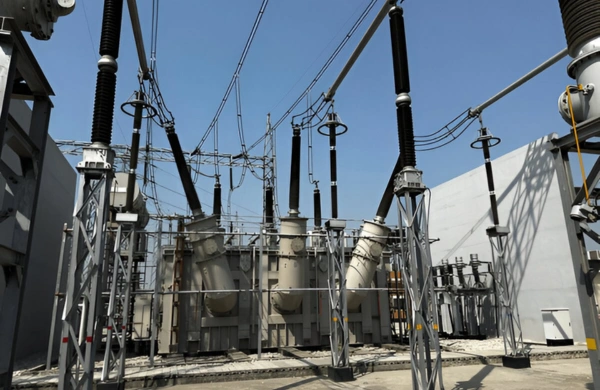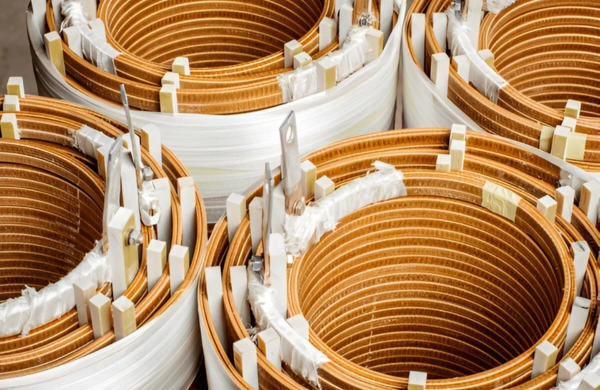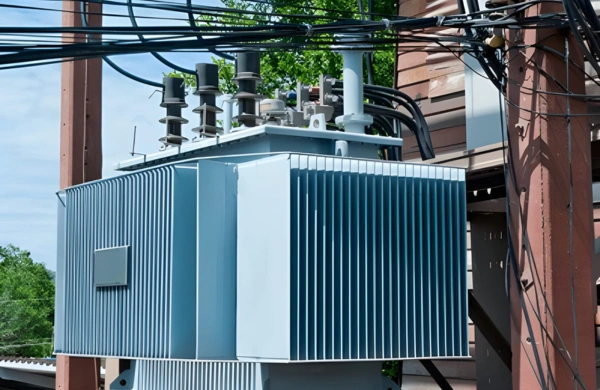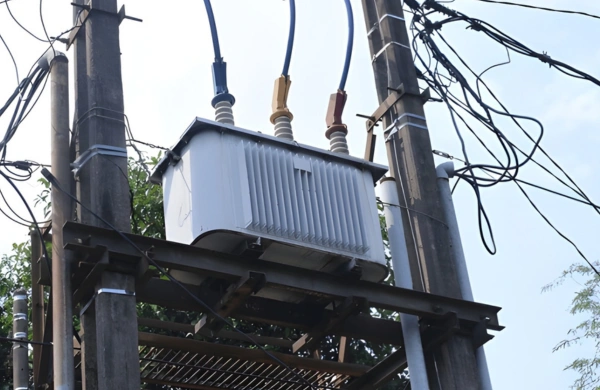Introduction
Modern industries depend on stable and efficient power systems to maintain equipment reliability and production consistency. However, fluctuating supply voltages and long-distance transmission often lead to inefficiencies, increased losses, and premature equipment wear. The solution lies in auto transformers — compact, cost-effective devices designed for precise voltage regulation and efficient power transfer.
Unlike conventional two-winding transformers, auto transformers use a single winding that serves both primary and secondary circuits, enabling higher efficiency, smaller size, and reduced cost.
Zetwerk designs and manufactures high-performance transformers built for industrial, utility, and power distribution applications across North America. Engineered to IEC 60076, IEEE C57, and ANSI standards, Zetwerk’s transformers deliver superior voltage control, high mechanical strength, and long-term reliability in demanding environments.
Know About Auto Transformers for Industrial Voltage Regulation
1. What Is an Auto Transformer?
An auto transformer is an electrical transformer with a single winding that acts as both the primary and secondary circuit. The winding is tapped at specific points to achieve desired voltage ratios.
This design eliminates the need for separate primary and secondary windings, resulting in a lighter, more compact transformer with higher efficiency.
Key characteristics:
- Single continuous winding with multiple tap points.
- Electrical connection between input and output circuits.
- Suitable for both step-up and step-down applications.
- Compact and cost-effective for medium to high-voltage systems.
Typical voltage regulation range: 5% to 20% adjustable via tap changers.
Auto transformers are widely used for voltage correction, motor starting, and interconnection between systems operating at different voltage levels.
2. Advantages of Auto Transformers
Auto transformers offer several distinct advantages over traditional two-winding transformers, particularly in industrial and utility applications.
Efficiency and Performance:
- Fewer copper losses due to reduced winding material.
- Lower impedance and higher voltage regulation accuracy.
- Efficiency levels exceeding 99% under rated load.
Compact Design:
- Up to 40% smaller and lighter than equivalent two-winding transformers.
- Easier to install in space-constrained facilities or modular substations.
Economic Advantage:
- Reduced material usage lowers manufacturing cost.
- Lower core losses translate into long-term energy savings.
Operational Benefits:
- Smooth voltage control for industrial processes.
- Ideal for long-distance power transfer or inter-system connections.
- Reduced magnetizing current and improved load handling.
Zetwerk optimizes each design for performance stability and thermal balance under continuous industrial load conditions.
3. Construction and Design Excellence
Zetwerk’s auto transformers are engineered using advanced materials and precision manufacturing to ensure efficiency, reliability, and safety.
Core Design:
Constructed from grain-oriented CRGO steel laminations or amorphous alloy for minimum core losses and noise. Step-lap joints ensure smooth magnetic flux distribution and reduced vibration.
Winding Configuration:
- Single winding with multiple tap connections.
- High-grade copper or aluminum conductors for low resistance.
- Thermally reinforced insulation using Nomex or epoxy varnish.
- Taps configured for step-up, step-down, or variable voltage operation.
Cooling Systems:
- AN / AF: Air-cooled for compact or indoor installations.
- ONAN / ONAF: Oil-cooled for high-power or outdoor applications.
- Integrated temperature sensors for real-time monitoring.
Tank and Enclosure:
Rugged steel or aluminum enclosures with IP23 to IP55 protection. Corrosion-resistant coatings extend service life in industrial or outdoor environments.
4. Electrical and Performance Specifications
Zetwerk’s auto transformers are designed for high efficiency and operational stability in a variety of voltage regulation and interconnection roles.
Typical specifications:
- Power rating: 50 kVA – 400 MVA
- Primary voltage: Up to 400 kV
- Voltage regulation: ±5% to ±20% via off-circuit or on-load tap changers
- Efficiency: ≥99%
- Frequency: 50 Hz or 60 Hz
- Insulation level: BIL up to 1,200 kV
- Thermal class: F or H
- Cooling: Air or oil-based depending on rating and environment
Each transformer is optimized for low leakage reactance, tight voltage regulation, and balanced short-circuit withstand capability, ensuring reliable long-term grid and industrial operation.
5. Industrial and Utility Applications
Auto transformers are used across industries that demand precise voltage regulation, efficient power transfer, or interconnection between voltage levels.
Primary applications include:
- Power transmission networks: Voltage stepping between 132 kV, 220 kV, and 400 kV systems.
- Industrial facilities: Stable voltage for heavy motors, furnaces, and drives.
- Motor starting: Reduced inrush current for large induction motors.
- HV test systems: Adjustable voltage control for electrical testing.
- Rail and metro systems: Smooth voltage supply to traction substations.
- Renewable integration: Interconnecting wind or solar generation at different voltage levels.
Zetwerk’s auto transformers provide versatile voltage adaptability while maintaining high efficiency and reliability across all operating conditions.
6. Testing and Quality Validation
Each Zetwerk transformer undergoes stringent quality testing to ensure performance, safety, and compliance with global standards.
Electrical tests:
- Ratio, polarity, and phase verification.
- Load and no-load loss measurement.
- Impedance and voltage regulation tests.
- Dielectric and impulse voltage tests.
- Short-circuit withstand verification.
Thermal and mechanical tests:
- Temperature rise tests for core and winding.
- Vibration and seismic endurance validation.
- Partial discharge tests to verify insulation integrity.
All testing complies with IEC 60076, IEEE C57.12, and ANSI C57.100 standards. Zetwerk’s in-house automated test facilities ensure repeatable accuracy and complete documentation for every shipment.
7. Safety and Reliability Features
Safety and operational reliability are integral to Zetwerk’s design philosophy.
Safety features include:
- Thermal sensors and protection relays for overload monitoring.
- Pressure relief valves and Buchholz relays (for oil-filled units).
- Grounding terminals and electrostatic shielding.
- Fire-retardant materials and self-extinguishing insulation systems.
- Protective enclosures with anti-condensation heaters for outdoor units.
These features ensure consistent, fault-tolerant operation — a critical requirement for industrial and utility environments.
8. Advantages Over Two-Winding Transformers
While two-winding transformers provide full electrical isolation, auto transformers offer higher efficiency and reduced size where isolation is not essential.
Comparison summary:
| Parameter | Auto Transformer | Two-Winding Transformer |
| Efficiency | Higher (≥99%) | Slightly lower |
| Size & Weight | 25–40% smaller | Bulkier |
| Cost | Lower | Higher due to extra winding |
| Voltage Regulation | Excellent | Very good |
| Electrical Isolation | Not present | Present |
| Maintenance | Low | Moderate |
Zetwerk assists customers in selecting between auto and two-winding designs based on electrical safety, load requirements, and cost optimization.
9. Zetwerk’s Manufacturing and Engineering Capabilities
Zetwerk’s integrated transformer manufacturing facilities combine advanced engineering, process control, and testing to ensure world-class performance.
Manufacturing highlights:
- CNC-controlled core cutting and stacking.
- Automated coil winding with precise conductor tension control.
- Vacuum drying and oil filling under controlled pressure.
- Digital FAT (Factory Acceptance Testing) with real-time data capture.
- ISO 9001, ISO 14001, and ISO 45001 certified systems.
Zetwerk’s engineering team supports complete design customization — from core material selection and tap changer configuration to enclosure type and cooling system optimization — ensuring reliable integration with North American power networks.
10. Supporting North American Industries
Zetwerk’s auto transformers are built for performance, efficiency, and compliance with North American standards.
Key advantages:
- Compliance with IEEE, IEC, ANSI, and CSA standards.
- Voltage class coverage up to 400 kV / 400 MVA.
- Custom tap changer configurations (OCTC/OLTC).
- Export-ready documentation and UL/CSA approvals.
- Proven reliability for industrial automation, utilities, and grid applications.
By combining compact design with advanced manufacturing and quality validation, Zetwerk ensures that every transformer meets the electrical, thermal, and safety expectations of modern North American industries.
Conclusion
Auto transformers provide the perfect balance of compact design, high efficiency, and precise voltage regulation for industrial and grid applications. Their simplicity, reliability, and economic advantages make them indispensable to today’s energy systems.
Zetwerk manufactures high-performance auto transformers engineered for long-term efficiency, mechanical durability, and compliance with global standards. Built using advanced materials and automated processes, each unit delivers stable, low-loss performance across a wide voltage range.
With in-house design, testing, and manufacturing control, Zetwerk continues to support North American utilities and industrial clients with transformer solutions that combine engineering precision, operational efficiency, and dependable power regulation.




FAQs
a. It regulates voltage efficiently and connects systems operating at different voltage levels.
a. Efficiency typically exceeds 99%, offering substantial energy savings.
a. No, they share a common winding — ideal for systems where isolation is not required.
a. Power utilities, industrial plants, rail systems, and renewable energy projects.
a. Yes. All designs comply with IEEE, IEC, ANSI, and CSA standards.








